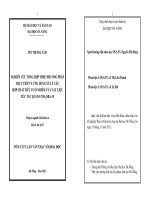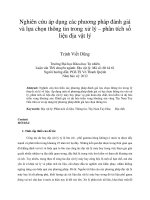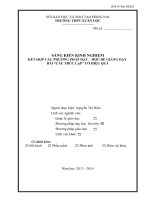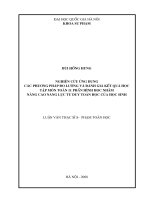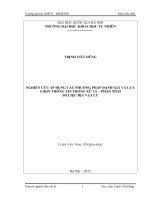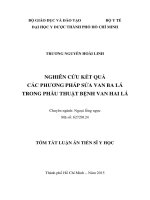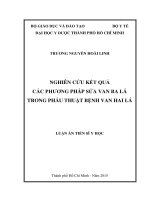nghiên cứu kết hợp các phương pháp hóa học và sinh học để xử lý nước thải sản xuất giấy và bột giấy ở viên chăn. luận văn ths. quản lý chất thải và xử lý vùng ô nhiễm
Bạn đang xem bản rút gọn của tài liệu. Xem và tải ngay bản đầy đủ của tài liệu tại đây (1.39 MB, 60 trang )
i
Vienglasy Mangnomek
INVESTIGATION ON A COMBINATION OF CHEMICAL AND
BIOLOGICAL METHODS FOR THE TREATMENT OF PULP AND
PAPER MILL WASTEWATER IN VIENTIANE
MASTER THESIS
Hanoi, November 2011
TECHNICAL UNIVERSITY OF DRESDEN
VNU UNIVERSITY OF SCIENCE
ii
TECHNICAL UNIVERSITY OF DRESDEN
VNU UNIVERSITY OF SCIENCE
Vienglasy Mangnomek
INVESTIGATION ON A COMBINATION OF CHEMICAL AND
BIOLOGICAL METHODS FOR THE TREATMENT OF PULP AND
PAPER MILL WASTEWATER IN VIENTIANE
Major: Waste Management and Contaminated Site Treatment
MASTER THESIS
SUPERVISOR: ASSOC. PROF. DR. BUI DUY CAM
ASSOC. PROF. DR. DO QUANG TRUNG
Hanoi, November 2011
iii
Table of contents
Abbreviations iv
List of tables v
List of figures vi
Abstracts vii
Acknowledgement viii
Introduction 1
CHAPTER I. LITERATURE STUDY 2
1.1.Status of environmental management in Vientiane 2
1.1.1. Introduction of Vientiane 2
1.1.2. Environmental issues in Vientiane 3
1.1.3. Situation of pulp and paper mill in Vientiane 7
1.2. The pulp and paper mill wastewater treatment technologies 11
1.2.1. Pulp and paper mill production 11
1.2.2. Sources of pollution in the production of pulp and paper mill 12
1.3. Some methods commonly using to treat with the wastewater 15
1.3.1. Physicochemical treatment 15
1.3.2. Membrane filtration 19
1.3.3. Biological treatment 21
CHAPTER II. EXPERIMENT 25
2.1. Research objective 25
2.2. Equipment and Chemicals………………… ……………………………… 26
iv
2.2.1. Equipments 26
2.2.2. Chemicals 26
2.3. Analitycal methods in the study 28
2.3.1. Determination of Chemical Oxygen Demand 28
2.3.2. Determination of Biochemical Oxygen Demand……………………… …29
2.3.3. Analysis of Ammonia content 30
2.3.4. Analysis of Nitrite and Nitrate 31
2.3.5. Procedure for the determination of Phosphate 33
2.4. Preparation of Pulp and paper mill samples 34
2.5. Physicochemical method for the pretreatment of pulp and paper mill
wastewater……………………………………………………………………… 35
2.5.1. Coagulation experiments for sample 1 and 2 35
2.5.2. Reduce of COD value by pH change for sample 3 35
2.6. Removal of COD in pulp and paper mill wastewater by combinated Aerobic
and Anaerobic circulatory System ……………………………………………….35
2.7. Material filling in column 36
CHAPTER III. RESULTS AND DISCUSSION 39
3.1. Pretreatment of pulp and paper mill wastewater by physicochemical methods39
3.1.1. Coagulation experiments for sample 1 and 2 39
3.1.2. Effect of the pH and PAC doseage to the reduction of COD in sample 3 41
3.2. Investigation of the biological treatment with activated sludge 43
3.2.1. Effect of retention time on COD removal for sample 1 43
3.2.2. Effect of retention time on COD removal for sample 2………………… 44
3.2.3. Effect of retention time on COD removal for sample 3 ………….……….45
3.3. Primary investigation on the treatment of pulp and paper mill wastewater by
the combination of circulatory aerobic and anaerobic system 46
v
3.3.1. The reduction of COD 47
3.3.2. The change of Ammonia 48
3.3.3. The change of Nitrite 49
3.3.4. The change of Nitrate…………………………………………………… 50
3.3.5. The change of Phosphrus 51
3.3.6. A proposed model for pulp and paper mill wastewater treatment for
Vientaine factories 52
Conclusions 54
References ……………………………………………………………………….55
vi
Abbreviations
AC Anaerobic Contact process
AF Anaerobic Filter
AOX Adsorbable organic halogens
BOD Biological Oxygen Demand
COD Chemical Oxygen Demand
CSOCA&A Circulatory system of combination of Aerobic and Anaerobic
DO Dissolved Oxygen
MLSS Mixed Liquor Suspended Solids
PAC Poly Aluminum Chloride
TSS Total suspended solids
vii
List of tables
Table 1. Wastewater Quality in Vientiane Capital Jan-Dec 2000[2]………… …5
Table 2. Industrial Growth in Lao PDR [2]………………………………… ……6
Table 3.Pollutants in the wastewater in the factory’s ponds[8]………………… 8
Table 4. Typical efficiencies of aerobic systems [9]…………………………… 22
Table 5. Anaerobic degradability of pulp and paper mill wastewater[19]… … 23
Table 6. Data of standard curve 30
Table 7. Data of ammonia standard curve……………………………………….32
Table 8. Data of nitrite standard curve making………………………………… 33
Table 9. Data of nitrate standard curve……………………………………… …34
Table 10. Data of phosphorus standard curve………………………………… 35
Table 11. Effect of PAC dosage to COD reduction for sample 1…………….….41
Table 12. Effection of coagulant PAC to COD removal …………………… …42
Table 13. Effection of pH changed to COD removal……………………………44
Table 14. Effection of coagulant PAC to COD removal ……………………… 44
Table 15. Data of effection of aerobic to COD removal ……………………… 46
Table 16. Data of effection of aerobic to COD removal…………………………47
Table 17. Data of effection of aerobic to COD removal…………………………48
Table 18. Data of effection of CSOCA&A to COD removal…………………….49
Table 19. Data of effection of CSOCA&A to NH
4
+
due to times……………… 51
Table 20. Data of effection of CSOCA&A to NO
2
2-
due to times……………… 51
Table 21. Data of effection of CSOCA&A to Nitrate due to times………………52
viii
Table 22. Data of effection of CSOCA&A to Phosphorus due to times……… 53
List of figures
Figure 1. Map of Lao PDR………………………………………………… ….2
Figure2 . Source flowchart from the production line in KPS paper mill in
Laos [8]………………………………………………………………….……… 10
Figure 3. Process description for pulp and paper mill factory[10]………….… 12
Figure 4. Pollutants from various sources of pulping and papermaking
[11]…………………………………………………………………………….….15
Figure 5. Diagram of Flocculate w11………………………………………… 27
Figure 6. Diagram of Aerobic system W11………………………………………27
Fignure 7. COD standard curve 30
Figure 8. Ammonia standard curve…………………………………….……… 32
Figure 9. Nitrite standard curve……………………………………………… …33
Figure 10. Nitrate standard curve………………………………………….…… 34
Figure 11. Phosphorus standard curve……………………….…………….…….35
Figure12. Diagram of combining Anaerobic and Aerobic system………… … 38
Figure 13 : Surface of porous material………………………………………… 39
Figure14. Microorganism layer……………………………………………… …38
Figure 15. Membrane of porous material after three times circularly pumping
water containing nutrient……………………………………………………… 38
Figure 16. Diagram of effection of PAC dosage to COD removal………… …38
Figure 17 Diagram of effection of coagulant PAC to COD removal…………….41
Figure 18. Diagram of effection of pH changed to COD removal… 42
Figure 19. Diagram of effection of coagulant PAC to COD removal………… 43
ix
Figure 20. Diagram of effection of aerobic to COD removal…………….… … 44
Figure 21. Diagram of effection of aerobic to COD removal……………….……45
Figure 22. Diagram of effection of aerobic to COD removal……………….……46
Figure 23. Diagram of effection of aerobic to COD………………………… …48
Figure 24. Diagram of effection of aerobic to Ammonia………………….…… 49
Figure 25. Diagram of effection of aerobic to Nitrite………………………… 50
Figure 26. Diagram of effection of aerobic to Nitrate……………………………51
Figure 27. Diagram of effection of aerobic to Phosphrus…………………… …51
Figure 28 : A purposed model wastewater treatment process using activated
sludge…………………………………………………………………….…… 54
x
Abstract
Lao PDR is a country rich in natural resources and its water resources are
vital in providing the basic needs for its people, socio-economic development of
the country. The scale and extent of environment problems in the urban areas of
Vientiane is relatively small compared to other cities in the region due to its
relatively small size and population, low population density, and relatively low
level of industrial activity. However, there are some water pollution problems in
major urban areas caused by various water uses by communities (households,
hotels, hospitals and entertainment centers). In addition, the actions of the
agricultural and industrial sectors have resulted in water pollution, including
mineral exploitation, pulp and paper mills factories and hydropower generation.
Therefore, in accordance with the Millennium Development Goals, the
government set targets in order to improve the local people’s access to safe
drinking water by the years 2015. For in Vientiane is one looking for manage
methods for treatment wastewater discharges.
In this study, the situation of environmental pollution in Vientiane in
general and from the pulp and paper mill wastewater in particularly was evaluated.
These are recognized that the environmental issues in Vientiane having problem.
The wastewater samples were collected from pulp and paper mill factories in Laos
and Vietnam for the experiments in laboratory of Environmental Chemistry, Hanoi
University of Science. The physicochemical and biological methods for the
treatment of wastewater were investigated. The results shown that, the pulp and
paper mill wastewater can be pretreated by the reduction of pH with dilute H
2
SO
4
acid at pH = 3; and by the coagulation with poly aluminum chloride (PAC). The
COD removal from 74.21% of sample 1 and 62.16% of sample 3. Then the
wastewater samples can be treated by using combined aerobic and anaerobic
system with efficiency of COD removal 94.99% of anaerobic and 90% for aerobic
xi
alone the reduction of the COD. For the wastewater sample 2 (taken from tissues
paper factory in Vientiane), the coagulation and follwing by biological treatment
with activated sludge are suitable methods.
Acknowledgement
The time of doing thesis in HUS is very special to me. It is the time for to
harvest my knowledge and to meet interesting Vietnamese friends. Thank you for
accepting the long hours, weekends and holidays I have spent working, for taking
good care of me during this time and for pushing just hard enough to make sure I
finally completed my thesis.
I would like to express my utmost appreciation and thanks to Prof. Dr. Bui
Duy Cam and Assoc. Prof. Dr. Do Quang Trung for them valuable guidance,
endurance, encouragement and support throughout this research.
Several people have given me assistance with the work in this thesis. I
thank Mr. Mai Xuan Thang and the late Mrs. Hoang Thu Trang for assistance in
the laboratory, and for assistance with the experimental set up.
Special thanks are extending to Prof. Bernd Bilitewski, Prof. Nguyen Thi
Diem Trang for your role in this circumstance.
Finally, the generous financial support by the DAAD. Also the support of
the Hanoi University of Science and Dresden University of Technology is
acknowledged.
xii
Introduction
Water are vital element for both of demand’s people and socio-economic
development of the country. As the population has grown, demand is also incresed and
has had to travel further in search of good quality water, marginal and polluted sources
have started being tapped. Therefore, investigation of the water quality in Vientaine is
very important because Laos is one of developing country looking for the suitable system
for wastewater treatment.
The amount and characteristics of the pulp and paper mill wastewater depend
highly on raw materials and processing conditions. The pulp and paper mill wastewater
may cause oxygen deficiency, acute or chronic toxicity, mutagenicity in recipient water
bodies. In some countries the discharge standands for pulp and paper mills include
conventional biochemical oxygen demand (BOD), chemical oxygen demand (COD) and
suspended solide also nutrients and organochlorine compounds expressed as adsorbable
organic halide (AOX). There are number of technique to reduce the discharged pulp and
paper mill wastewater. The mechanical treatment method with primary clarifies is usually
applied to remove the wastewater solids and the organic load while dissolved organics
are removed in aerated lagoons and/or activated sludge system, the most commonly
applied biological processes. However, these processes are expensive and none is
consider to be economically viable when this is done as standard process. Biological
method have been found to be more effective and eco-friendly since they are capable of
degrading not only lignin but also chloro-oganics contributing to AOX.
In my study, the overview of the wastewater treatment technologies for pulp and
paper mill factories are conducted for the purpose of applying to Laos and both methods
of chemical and biological ones are investigated for the treatment of pulp and paper mill
wastewater in Vientiane. The real samples from Laos, Vietnam pulp and paper mill
wastewater have been tested.
CHAPTER I. LITERATURE STUDY
1.1. Status of environmental management in Vientiane
1.1.1. Introduction of Vientiane
The Lao People’s Democratic Republic (Lao PDR) is near to Myanmar,
Cambodia, the People’s Republic of China , Thailand, and Viet Nam. The total land area
of the country is 236,800 square kilometers (km
2
) with a largely mountainous
xiii
topography. The capital, Vientiane (See picture 1 - Map of Lao PDR), however lies on a
plain. The country is bordered on the west by the Mekong River, making the river an
important artery for transportation, communications, and trade with other countries
sharing tributaries of the Mekong River.
Set in the heart of Vientiane, Laos from the north latitude 17 45'50 - 22'38 18
09'37 5'40 and 102 - 103 east longitude and the natural area 3.920 km
2
. Vientiane is the 9
District: Chanthabuly, Sikottabong, Xaysettha, Sisattanak, Naxaythong, Saythany,
Hatsaiphong, Saengthong Phakngum area and population density level of economic
development of each district is different. Entire Vientiane has 500 villages, of which
urban area accounts for 76% of villages, rural areas account for only 24%. Population
Vientiane has highest level of culture, a spirit of hard-working, patriotic tradition and
unyielding will to revolution [1].
Figure 1. Map of Lao PDR
Lao PDR is a rich country in natural resources and its water resources are vital in
providing the basic needs for its people, for socio-economic development of the country
and for the ecological systems. The availability of water resources has created favourable
conditions for the Laos and for the socio-economic development of the country, but it is
essential that the country protects and manages water and water resources in a sustainable
way. Despite this a scarcity of water for both drinking and irrigation purposes is common
in some provinces particularly in remote areas. As the population has grown, and has had
to travel further in search of good quality water, marginal and polluted sources have
started being tapped. The major surface water resources are from rivers, streams and via
xiv
gravity fed systems and through the protection of spring water. Groundwater is sourced
from boreholes with hand pumps and from protected dug wells. Rainwater is also
harvested in reservoirs or tanks and individual collection jars [2].
1.1.2. Environmental issues in Vientiane
The scale and extent of environment problems in the urban areas of Vientiane is
relatively small compared to other cities in the region due to its relatively small size and
population, low population density, and relatively low level of industrial activity.
However, despite recent investments, there remain few systems in place to ensure that all,
and in particular the poor, benefit from environmental improvements and environmental
problems can be controlled in the future (EPL, 1999).
The Water Quality Laboratory of the Ministry of Agriculture and Forestry
reported that the quality of water in Lao PDR has generally been good according to the
past 15 years of monitoring data. However, there are some water pollution problems in
major urban areas caused by various water used by communities (households, hotels,
hospitals and entertainment centers). In addition, the actions of the agricultural and
industrial sectors have resulted in water pollution, including mineral exploitation and
hydropower generation. The degradation of water bodies and catchments due to
sedimentation, land erosion and drying out continues [3],[4].
Poverty and Access to Clean Water and Sanitation throughout Lao PDR, there is
a high incidence of diarrhea and dysentery caused in part by inadequate water supply,
poor sanitation and sewerage, and absence of wastewater treatment facilities. With rising
populations in urban and upland areas, water pollution is getting worse. Also the poorest
districts have less than half the national average of daily water use, due to less access to
water for either personal use or irrigation purposes. For this reason, various challenges
exist in the field of water quality monitoring, modeling and other technical strengthening;
however, there is a need for a more systematic approach. Currently, some ministries and
departments are responsible for water resources independently carry out water quality
management, such as water quality monitoring and analysis. The Water Resources and
Environment Administration (WREA) needs to play an active and leading role in water
quality management in line with its mandate on water resources and environment. Also,
stronger water quality policies and strategies are needed to deal with the rapid
development of water resources and possible impacts on water quality and ecosystems.
The updating of the National Water Resources Policy and Strategy and the
possible review of the Law on Water and Water Resources will provide the opportunity
for this policy and strategy development. Reviewing and setting coordinated water
xv
quality monitoring standards and procedures need to be considered. Furthermore,
capacity and systematic coordination procedures and mechanisms among agencies
responsible for overall and sectored water quality monitoring and management need to be
built [4].
Environmental measures used in solid waste management in Vientiane, including
market and non-market instruments as well as public education and training programmers
(moral suasion). Under pressure from rapid demographic growth, socio-economic
development and urbanization, however, water quality is deteriorating. In urban areas,
pollutants from roads, commercial and industrial areas, and private properties wash into
drains and watercourses. Litter, dust and dirt, oil and grease, particles of rubber
compounds from tires, particles of metal, glass and plastic from vehicles, and lead are
common pollutants. Residential properties and open spaces contribute sediments and
nutrients [5]. Urban drains also act as secondary sewers carrying industrial discharges,
septic tank seepage and overflows in wet weather. It is common practice to dispose of
sewage to surface drains and drainage channels. As a result, wastewater is invariably
contaminated with faecal matter from latrines and coli-form septic tank effluent.
Wastewater monitoring was conducted in Vientiane in 2002. Samples were collected
from 15 monitoring stations. Parameters were measured: pH, conductivity, alkalinity,
BOD
5
, COD and temperature. The monitoring results showed that the average of all
parameters were within acceptable limits, although certain samples exceeded standards
for Class A wastewater discharge, issued by the Government in 1994 [2].
Table 1. Wastewater Quality in Vientiane Capital Jan-Dec 2000 [2]
Parameters
Unit
Range of
Avg Results
Standard
pH
6.38-8.44
7.34
6 – 9.5
Conductivity
us/cm
110 - 782
362.62
Alkalinity
mg/l
57 – 250
(CaCo3)
175.56
BOD
5
mg/l
5 – 35 (O2)
14.09
< 20
COD
mg/l
70 – 200 (O2)
115.93
< 120
Temperature
0
C
12.2 - 30
24.42
Lao PDR has taken significant step to ensure that the country’s environment and
natural resources, particularly the forests and use are sustainable management. Since
xvi
1993, the institutional framework has been established and followed up by a place of
legal framework for instances: Environmental law, land law, forestry law, water and
water resources law, and others [3]. However, the growing number of industries has
increased the risk of pollution. The larger mills and industries of concern in Lao PDR are
pulp and paper, timber, food processing and garment manufacturing. Most of these have
only limited wastewater treatment systems for reducing waste concentrations and loads in
the final effluents to waterways. Likewise, the increasingly large number of smaller
industries also produces an increasing risk of pollution. There has been an increase in the
output of in the industrial sector from 8 percent of GDP in 1999 to 11.3 percent in 2003.
The total number of industries has grown nearly four-fold from 1994 to 2003 (Table 2).
Therefore, in accordance with the Millennium Development Goals, the government set
targets in oder to improve the local people’s access to safe drinking water by the years
2015.
Table 2. Industrial Growth in Lao PDR [2]
Large(>100
employees)
Medium(10-100
employees)
Small(<10
employees)
Total
1994
80
343
5.523
5.946
1995
89
363
10.374
10.826
1996
112
408
14.134
14.654
1997
119
437
15.375
15.931
1998
99
462
15.953
16.514
1999
94
493
19.806
20.393
2000
95
512
20.962
21.569
2001
116
542
22.916
23.574
2002
112
604
24.026
24.742
2003
119
614
24.874
25.607
For this reason, the government set targets in the Socio-Economic Development
Strategy up to the year 2020 for the five years plans. For the National Growth and
Poverty Eradication Strategy, the National Environment Strategy up to the year 2020 and
the Action Plan 2006–2010 highlight the importance of the sustainable use and
management of natural resources, specifically water. Moreover, the Environment
Protection Law (EPL), the Water and Water Resources Law and the regulation on
wastewater discharge forbid any water pollution and propose that the personal sector be
responsible for the environmental damage and the related social and economic effects
that result from their industrial activities, specifically from wastewater and air emissions.
xvii
The Government’s increasing focus on the importance of the private sector, in
particular small and medium-sized enterprises (SMEs), is commendable. It needs,
however, more strongly emphasize the importance of export orientation and move away
from import substitution by various means of protection, a policy that most countries in
the world, often after having experienced costly mistakes, have abandoned [6].
Finally, in according by the presentment of the Minister of Industry and
Commerce, in 2005 has regulation issued of the main condition on the industrial factories
[7] are follows :
a) To prohibit discharging directly or indirectly into public water that may have
adverse impacts on ecology of water body, health of people or use of water,
b) To require getting approval on wastewater treatment system before starting
construction of factories from Director of Industry Department of the Ministry or
Province as well as submit a treatment approach, waste management system plan.
c) To rein stalling wastewater treatment system, volume measurement equipment,
and other necessary facilities for monitoring, and sample analysis,
d) To require frequently monitoring monitoring and analyzing the wastewater, and
report the analysis results to Director of Industry Department of the Ministry or
Province,
e) To require recording the daily use of chemical substances and explaining the
purpose of their use.
1.1.3. Situation of pulp and paper mill in Vientiane
There are six pulp and paper mills in which five factory located in Vientiane
Capital City and one in Vientiane Province. For pulp and paper mills factories were
processed as to less than 200 tones of output per day, and small scale have to compared
with in near countries. KPS Paper mill is one factory in Vientiane Capital, this is factory
using water from stored in three underground buffer tanks and from supply water to the
manufacture process. The raw material processed is bamboo, which is reduced to chips
by a cutter. For delignification, the chips are immersed in a sequence of five tanks
containing caustic soda, an alkaline solution. Sulfur is also added. After concentration,
the chips are removed manually and placed in a grinder. The pulp produced in the grinder
station is mixed with recycled paper (which includes rejected and surplus paper) in a
water tank. The flow chart of the production line is shown in figure 2. After screening,
the mixture is transferred into the paper-making machines. The finished paper is then
xviii
colored, cut and stamped before being packed for export. The plant uses sodium
carbonate (Na
2
CO
3
) or sodium hydroxide (NaOH) (or cold soda) mixed with sulfur (S)
amount 1,688 tones/year to deepen of the paper it manufactures and exports. In the
factory is general discharged effluent water amount 600 m
3
/day.
Wastewater discharges from the factory has not installed any effluent treatment
system even though it is pre-determined in the factory’s project document. Therefore, the
wastewater from the factory are two types of first black wastewater from the
delignification stage of the pulping process, and second white wastewater from the paper
making process. The black wastewater is discharged directly addicted to the local steam
and a series of ponds in the factory through two separated pipeline systems according [8]
is shown in table1.
xix
Table 3.Pollutants in the wastewater in the factory’s ponds [8]
Parameter
Unit
White
wastewater
discharged
Black
wastewater
discharged
Maximum allowed
(industrial wastewater
Discharge regulation
326/MIH )
pH
-
10
9.23
6-9.5
Color
CU
160
14,000
-
BOD
5
mg/l
135
475
90
COD
mg/l
3,238
7,040
-
TSS
mg/l
292
6,435
60
TDS
mg/l
2,572
15,548
3,500
Cl-
mg/l
404.9
1,410
500
Mixing
Grinding
Screening
NaOH +
water
Water
Bamboo
Recycling
White wastewater
Wastewater
Bamboo surplue Dust
Chipping
Delignification
Pulping Process
Black wastewater
Solid waste
xx
Figure 2 . Source flowchart from the production line in KPS paper mill in Laos [8]
1.2. The pulp and paper mill wastewater treatment technologies
1.2.1. Pulp and paper mill production
The characteristics of the wastewater generated from various processes of the
pulp and paper industry depend upon the type of process, type of the wood materials,
process technology applied, management practices, internal recirculation of the effluent
for recovery, and the amount of water to be used in the particular process.
That the load of chlorinated phenols and acids in the wastewaters of hardwood
kraft mill was three to eight times lower than it was in the soft wood kraft mill. The
pulping and paper making process is prominent compound in the produce pollutants at
various stages. The wastewater pollution load from individual pulping and papermaking
process. There have
1. Mechanical forces in the presence of water (mechanical pulping). The process
involves passing a block of wood, usually debarked, through a rotating grindstone where
the fires are stripped of and suspended in water.
2. Chemical pulping which utilizes significantly large amounts of chemicals to
break down the wood in the presence of heat and pressure. The spent liquor is then either
recycled or disposed of by burning for heat recovery.
3. A combination of the two (chemical thermo-mechanical pulping). The wood is
first partially softened by chemicals and the remainder of the pulping proceeds with
xxi
mechanical force. According by G. Thompson, J. Swain, M. Kay, C.F. Forster [10] in
conventional mechanical pulping, the dissolved organic material from the wood is split
between the pulp passing onto the paper machine and that going to waste. The
preponderance of the pollutants which go forward to the paper machine will subsequently
exist released in the paper machine wastewater, except where the process is operated in a
closed loop system. In difference, chemical pulping plants, with recovery systems in
place, find that most of the organic pollutants dissolved during pulping are retained in the
recovered liquors which are generally incinerated. The highest wastewater losses are
found in mills which operate chemi-mechanical process. However, the wood pulping and
production of the paper products generate a considerable amount of pollutants
characterized by biochemical oxygen demand (BOD), chemical oxygen demand (COD),
suspended solids (SS), toxicity, and color when untreated or poorly treated effluents are
discharged to receiving water. Pulp and paper mills generate varieties of pollutants
depending upon the type of the pulping process. This is made from cellulose fibers,
carbohydrates as sugar and lignin, and is adhesive substance for the cellulose fibers. The
current environmental limitations have caused the decrease of the consumption of the
natural resources for this industrial use. So, in this industry the recycling of fibrous raw
materials and/or alternative is the high water usage, between 20,000 and 60,000 gallons/t
of products, results in large amounts of wastewater generation [11, [12]. For the water
utilization dependents on the technology and the product obtained were 3-8 m
3
/t Carton
of product, 10-15 m
3
/t Newspaper of product, 15-20 m
3
/t Paper tissue of product, and
Writing paper 10- 20 m
3
/t of product [13]. The wastewater from the papermaking and de-
inking process differs from the pulping process due to there being no breakdown of raw
material, other than the discards of cleaning and screening. Foremost sources of pollutant
releases in pulp and paper manufacture in figure 3 Process description for pulp and paper
mill factory it show below:
Figure 3. Process description for pulp and paper mill factory [10]
1.2.2. Sources of pollution in the production of pulp and paper mil
Mechanical
pulping
Chemical
pulping
Chemo-mechanical pulping
(CMP)
Thermo-mechanical
pulping (TMP)
Papermaking
xxii
The pulp and paper industry possessions (wood, water) and fossil fuels, electricity
and a significant contributor of pollution discharges to the emissions from pulp and paper
mills to air, water and land gives a serious impact on environment quality that ultimately
affects the health of both human and ecosystems. However, the recovery and reuse of
water can increase the concentration of organic and inorganic species, which in turn can
affect paper formation, increase bacterial loading or lead to corrosion and odours.
According by D. Pokhrel, T.Viraraghavan [10] in boring the wood pulping and
production of the paper products cause a significant quantity of pollutants characterized
by biochemical oxygen demand (BOD), chemical oxygen demand (COD), suspended
solids (SS), toxicity, and color as untreated effluents are discharged to receiving water.
The concentration of total wood extractives in the different fractions of the
influent and effluent from the activated sludge plant. 88% of the wood extractives were
removed in the activated sludge process. In the determination of wood extractives the
normal procedure is to remove larger particles by centrifugation before extraction in
order to obtain reproducible results for dissolved and colloidal substances [11]. However,
integrated Kraft pulp and paper mill wastewater was characterized before (influent) and
after (effluent) the activated sludge process by micro-filtration and ultra-filtration into
different size fractions. Wood extractives, lignin, suspended solids and certain trace
elements were determined in each fraction. Forty four percent of the resin and fatty acids
in the influent (12.8 mg/L) occurred in particles, 20% as colloids (0.45 mm–3 kDa) and
36% in the fraction. The corresponding values for sterols (1.5 mg/L) were 5, 46 and 49%.
In the effluent, resin and fatty acids (1.45 mg/L) and sterols (0.26 mg/L), as well as a
small proportion in particles. b-sitosterol was present in particles in the effluent (88 _ 50
mg/L) [14].
The used effluents were obtained from the biggest pulp and paper mill. In the mill
produces about 140 t/d of pulp from soft and hard woods. A six-stage bleaching process
chlorination, extraction, hypochlorite, chlorine dioxide, extraction, chlorine dioxide is
useful to the cooked Kraft pulp. Combined leaching chlorination, extraction,
hypochlorite, chlorine dioxide, extraction, chlorine dioxide and the first three steps of the
bleaching effluents constitute 30% and 60% of the total flow rate of pulp mill effluent,
respectively. Spent effluents from the individual bleaching stages of were used in the
ozonation experiments. The pretreated chlorination, extraction, hypochlorite stage
bleaching effluent was mixed with effluents from other stages of the bleaching process
and all other streams of the mill at a ratio of 1:1:1.39. Algal treatment was applied to both
raw and pre-treated combined effluents [15]. Of the wood Although the existence of
xxiii
chlorinated compounds in the effluents has decreased, a discussion about the possible
environmental effects of elemental-chlorine-free (ECF) and total-chlorine-free (TCF)
bleached pulp mill effluents has arisen, and chronic effects on aquatic organisms have
still been found[16]. The characteristics of the wastewater generated from various
processes of the pulp and paper industry depend upon the type of process, type of the
wood materials, process technology applied, management practices, internal recirculation
of the effluent for recovery, and the amount of water to be used in the particular process
and others are generated in the pulp and paper making process show in figure 3.
Pollution from the pulp and paper industry can be minimized by various internal process
changes and management measures such as the Best Available Technology (BAT).
Therefore, there were necessary to bring in some kind of treatment of the
wastewater. For the treatment method and increased knowledge about the underlying
processes, there is a complete preference of different mechanical, physical, chemical and
biological methods that can be combined in different ways in order to achieve cost
efficient wastewater treatment. The wastewater composition and the amounts of different
substances in wastewater, and one fundamental dissection are between dissolved
substances and particular matter. For the common methods are analyses of total solids
(TS), total suspended solids (TSS), and volatile suspended solids (VSS), one more large
division is between inorganic and organic compounds. The determination of ammonium -
nitrogen, other phosphate and nitrate-nitrogen are examples of some of these specific
methods. Organic compounds are applying measured by lumping methods, such as total
organic carbon (TOC) and dissolved organic carbon (DOC). A lot of method have been
developed in order to determine how much pollutants a wastewater is made are chemical
oxygen demand (COD) and biological oxygen demand (BOD). However, have many
different methods represent the most common ones in the wastewater treatment field. The
mainly important method for characterizing the wastewater is COD. Beside that methods
comparable to TOC could also be used but then they have to be correlated to COD. The
amount of degradable matter in the wastewater can be determined with BOD but this
method while only gives an estimate. VSS is the best measure of the amount of microbial
biomass in the wastewater treatment plant. TSS could also be used but inorganic matter
could bias the result and cause an overestimation of the amount of microorganisms in the
system.
Wood
preparation
The soils, drit’s, and barks are removed from the wood and
chips are separated from the barks and water is used to
clean the wood. Thus the wastewater from this source
contains suspended solids, BOD, dirt, girt, fibers etc.
The wastewater generated from digester house is called
xxiv
Figure 4. Pollutants from various sources of pulping and papermaking [11]
1.3. Some methods commonly using to treat with the wastewater
1.3.1. Physicochemical treatment
Physicochemical treatment processes include removal of suspended solids,
colloidal particles, floating matters, colors, and toxic compounds by sedimentation,
flotation, screening, adsorption, coagulation, oxidation, ozonation, electrolysis, reverse
osmosis, ultrafiltration, and nano-filtration technologies.
1.3.1.1. Coagulation and precipitation
Chemical coagulation followed by sedimentation is a probed technique for the
treatment of high suspended solids wastewater especially those formed by colloidal
matters. Research and practical applications have shown that coagulation will lower the
pollution load and could generate an adequate water recovery. Coagulation and
flocculation is normally employed in the tertiary treatment in the case of pulp and paper
xxv
mill wastewater treatment and not commonly adopted in the primary treatment. It carried
out a comparative study of horseradish peroxide (chitosan) and other coagulants such as
(Al
2
(SO
4
)
3
), hexamethylene diamine epichlorohydrin polycondensate (HE),
polyethyleneimine (PEI), to remove adsorbable organic halides (AOX), total organic
carbon (TOC), and color [9]. Coagulation is mainly induced mainly reduced by inorganic
metal salts, e.g. aluminum and ferric sulphates and chloride. Polyelectrolytes of various
structures, e.g. polyacrylamides, chitosan, polysaccharides, polyvinyl and many more are
usually used as coagulant aids to enhance the formation of larger floc in order to improve
the rate of sedimentation. According to A.L. Ahmad, S.S. Wong, T.T. Teng, A. Zuhairi
[17] pulp and paper mill wastewater was treated by using the alum and polyaluminum
chloride (PACl) alone and in coupled with cationic polyacrylamide (C-PAM) and anionic
polyacrylamide (A-PAM). The reduction efficiency of turbidity and chemical oxygen
demand (COD), removal efficiency of total suspended solids (TSS), sludge volume index
(SVI) and settling time are the main evaluating parameters. In coagulation–flocculation
process using single coagulant, coagulant dosage and pH play an important role in
determining the coagulation efficiency. At the optimum alum dosage of 1000 mg/L and
optimum pH of 6.0, turbidity reduction is found to be 99.8%, TSS removal is 99.4% and
COD reduction is 91%. The optimum dosage and pH for PACl are 500 mg/L and 6.0,
respectively, at which it gives 99.9% reduction of turbidity, 99.5% of TSS removal and
91.3% of COD reduction. A combination of inorganic coagulant and flocculant or
polymer is applied in which alum and PACl are used coupled with the C-PAM
(Organopol 5415) and A-PAM (Chemfloc 430A). Overall, alum coupled with Organopol
5415 is the best system among all systems studied. It gives 99.7% reduction of turbidity,
99.5% removal of TSS and 95.6% reduction of COD, and at the same time with low SVI
(38 mL/g) and low settling time.
The combined method (coagulation followed by photocatalysis) has been
developed by Angela Claudia Rodrigues et al [18] to improve the efficiency of the
treatment of wastewater from pulp and paper mill factories. First, the effluent was
submitted to the coagulation–flocculation treatment by applying FeCl
3
as the coagulating
agent and chitosan as an auxiliary. In sequence, the aqueous soluble phase obtained from
the first treatmentwas submitted to a UV/TiO
2
/H
2
O
2
system using mercury lamps. The
optimized coagulation experimental conditions were chosen: pH 6.0, 80 mg L
−1
of
FeCl
3
·6H
2
O, and 50 mg L
−1
of chitosan. The optimized photocatalysis conditions were:
pH 3.0 in 0.50 g L
−1
of TiO
2
and 10 mmol L
−1
of H
2
O
2
. COD values for the in natura
sample was 1303 mg L
−1
and after the optimized conditions of coagulation without
